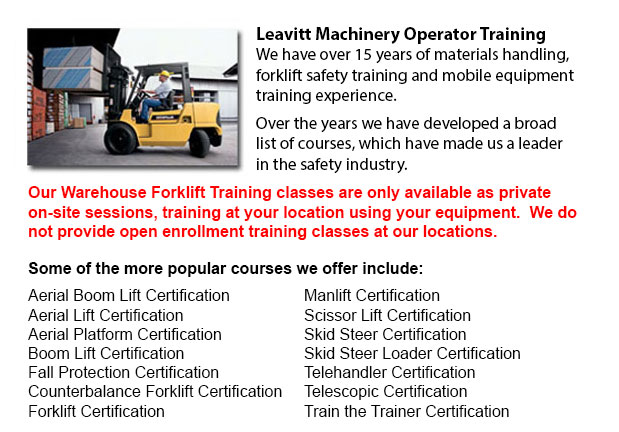
Vernon Warehouse Forklift Safety Training - The corporation will face claims for liability when damage and injuries are sustained in an accident at the workplace. Warehouses can be a hazardous place to work for its workers, making employee safety a top priority for the business. Warehouse safety training is among the most effective measures to protect employees, while minimizing expenses associated with injuries and accidents.
The warehouse holds large amounts of stock and materials which may pose dangers, specially when these are being transported. The moving of stock making use of a powered equipment or by hand could lead to injuries the employees' hands, fingers, feet and toes. Tripping, falling and slipping are common causes of injury. Heavy stuff could fall off shelves and harm personnel. Forklifts and other machinery carry inherent risks as they manipulate heavily laden pallets. Improper lifting is a common source of back injuries. Even box cutters, nails and splinters could result in harm.
Warehouse conditions can change from one moment to the next, depending on the substances or materials being handling, the work being performed and the machine being utilized. Because of the various potential hazards in warehouse environment, warehouse operations are regulated by many various standards. There are rules for storage and material handling, for walking and working surfaces, and rules governing the selection and use of PPE (personal protective equipment).
The majority of the safety regulations covered by a business would consist of common sense regulations. Rules that warehouse personnel should be quite familiar with comprise:
1. When working in a warehouse, safety is a top priority at all times.
2. PPE, like for instance gloves, safety shoes, eye protection and hard hats, should be worn as appropriate.
3. Inspect for hazards and report them or correct them.
4. Observe and Follow warning signs and signals.
5. Watch where you're going and concentrate on what you're doing.
6. Pay attention to the work that others are doing nearby, especially when they are working with forklifts and various dangerous equipment.
7. Store and stack materials so that they're secure and stable.
To be able to guarantee a safe warehouse, workers must adhere to good housekeeping rules. Basic regulations for housekeeping includes keeping the aisles and floors clear of things like for example cords and wires. Never perch items insecurely on a surface. When spills occur, clean up immediately. Dispose of trash in correct containers. Keep fire exits, fire extinguishers and sprinklers accessible. Put box cutters and other sharp tools away instantly after use. Report tripping hazards like for example damaged or loose flooring.
-
Vernon Heavy Equipment Training Programs
Vernon Heavy Equipment Training Programs - At whatever given construction site, there are often different types of machinery which are ready to be used. These heavy and light machines need both operators to run them and mechanics to fix them. Trainee... More -
Vernon Forklift Safety Training
Vernon Forklift Safety Training - People wanting work in industries that operate lift trucks should undergo a forklift safety training program before becoming a certified operator of a lift truck. There are a lot of ways to go about acquiring forklif... More -
Vernon Aerial Boom Lift Ticket
Vernon Aerial Boom Lift Ticket - Aerial platform lifts can accommodate various odd jobs involving high and tough reaching places. Normally used to complete regular preservation in structures with tall ceilings, prune tree branches, elevate heavy shel... More -
Vernon Manlift Safety Training
Vernon Manlift Safety Training - Manlift operators need to be cognizant and aware of all the potential dangers which are associated with particular classes of scissor lifts. They need to be able to operate the scissor lift in a way that protects not... More -
Vernon Forklift License
Vernon Forklift License - Obtaining a forklift certification or forklift license in North America will require the one training to carry out hands-on training in addition to classroom instruction. The provincial, federal and state regulatory bodies a... More -
Narrow Aisle Forklift, Order Picker, Electric Pallet Jack, Electric Pallet Truck Certification in Vernon
A pallet lift is a model of equipment dedicated in the transporting of pallets of many dimensions and weights. They can be utilized as an appendage for forklifts, cranes and other styles of heavy machinery or be applied on their own. Pallet hoists ar... More -
Vernon Boom Lift Safety Training
Vernon Boom Lift Safey Training - Boom lifts are a type of elevated work platform or aerial lifting device which are commonly utilized in construction, industry, and warehousing. Boom lifts can be utilized in practically any surroundings because of t... More -
Vernon Manlift Operator Training
Vernon Manlift Operator Training - The aerial lift or manlift is a specialized kind of hydraulic platform that is designed to lift a person vertically giving it an alternate name of a vertical personnel lift. These machinery are widely utilized for a... More

Forklift Certification Vernon
TOLL FREE: 1-888-254-6157
Vernon, British Columbia
forkliftcertificationvernon.com
Email Us
About Us


